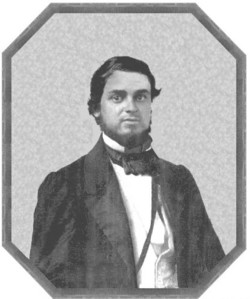"If they're hungry, let them eat grass or their own dung."
Reprint from Telelaget of America
The Sioux Uprising of 1862 was primarily the result of the government's failure to honor the terms of the Treaty of Traverse de Sioux in 1851. The Indians gave up over 20 million acres of land, preserving for themselves a reservation of the land on each side of the Minnesota river, roughly from the Minnesota border to New Ulm. The government did not honor these terms, and a number of pioneer settlements began to sprang up on what legally was reservation land. The government promised yearly payments to the tribes for the land they gave up; the payments were often late and were gobbled up by the trading post owners who charged outrageous prices but offered credit to Indians during the year. In the summer of 1862, the payments were once again late and the Indians were starving.
The Sioux Uprising of 1862 was primarily the result of the government's failure to honor the terms of the Treaty of Traverse de Sioux in 1851. The Indians gave up over 20 million acres of land, preserving for themselves a reservation of the land on each side of the Minnesota river, roughly from the Minnesota border to New Ulm. The government did not honor these terms, and a number of pioneer settlements began to sprang up on what legally was reservation land. The government promised yearly payments to the tribes for the land they gave up; the payments were often late and were gobbled up by the trading post owners who charged outrageous prices but offered credit to Indians during the year. In the summer of 1862, the payments were once again late and the Indians were starving.
On August 4, 1862, representatives of the northern Sissetowan and Wahpeton Dakota bands met at the Upper Sioux Agency in the northwestern part of the reservation and successfully negotiated to obtain food. When two other bands of the Dakota, the southern Mdewakanton and the Wahpekute, turned to the Lower Sioux Agency for supplies on August 15, 1862, they were rejected. Indian Agent (and Minnesota State Senator) Thomas Galbraith managed the area and would not distribute food without payment to these bands.
With the American army focused on the Civil War, it seemed to be to the Indians' advantage to take military action to redress these grievances. Minnesota's pioneers were largely unaware of the just nature of the Indians' plight, and they suffered prolonged and intense terror in the fall of 1862. Estimates vary but between 450 and 800 settlers were killed. Large areas were depopulated as panic-stricken settlers rushed to Fort Ridgely or to towns like St. Peter. The settlers formed groups of citizen soldiers to protect themselves. They gave themselves names like The Le Sueur Tigers, St. Peter Guards, and the Scandinavian Guards of Nicollet County. Soldiers rushed from St. Paul to defend the counties of southern Minnesota.
The uprising lasted only six weeks. 425 Indians were indicted; 303 were sentenced to hang and 20 to imprisonment. President Lincoln commuted all but 38 of the death sentences. A massive scaffold was built, and on the day after Christmas in 1862, all 38 men and boys were hung simultaneously. It was the largest public execution in American history.
This American Life
(To listen to the oral documentary, click above)
(To listen to the oral documentary, click above)
Growing up in Mankato, Minnesota, John Biewen says, nobody ever talked about the most important historical event ever to happen there: in 1862, it was the site of the largest mass execution in U.S. history. Thirty-eight Dakota Indians were hanged after a war with white settlers. John went back to Minnesota to figure out what really happened 150 years ago, and why Minnesotans didn’t talk about it much after.



Comments
Post a Comment